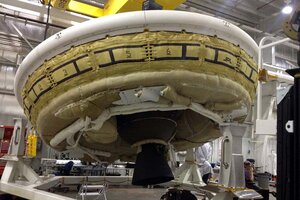Mission to Mars? What US panel says needs to be done, now.
A panel assessing the US human spaceflight program says that to reach Mars will require 'a very different way of doing things,' including a bigger NASA budget and cuts to other space programs.

A saucer-shaped test vehicle holding equipment for landing large payloads on Mars is seen in the Missile Assembly Building at the US Navy's Pacific Missile Range Facility at Kekaha on the island of Kaua‘i in Hawaii.
NASA/AP
If the US government wants to send humans to explore Mars within the next few decades, it's time to fish or cut bait.
That's the Dutch-uncle message underlying a report released Wednesday from the National Research Council's Committee on Human Spaceflight.
"Do you want to go to Mars, or don't you?" asked former Indiana Gov. Mitchell Daniels Jr., co-chairman of the committee, in a briefing on the report.
If the answer is yes, it will require "a very different way of doing business," said Governor Daniels, now president of Purdue University, who co-chaired the panel with Cornell University planetary scientist Jonathan Lunine.
Congress called for the panel’s study in NASA's fiscal 2010 authorization bill. Lawmakers sought the panel's recommendations for conducting NASA's human spaceflight program at a time when the Obama administration was following the lead of its own advisory panel in overhauling the program.
What this “different way of doing business” means includes the following:
• Presidents and future members of Congress would need to agree to increase NASA's budget for human spaceflight, currently $8 billion or 0.2 percent of all federal outlays, at roughly double the rate of inflation for decades. Flat funding or increases that only match inflation will be fiscal roads to nowhere, the panel holds.
• NASA would need to maintain a "robust" unmanned planetary and space-science exploration program, which not only would help inform the human-spaceflight program but continue to keep the public engaged.
• Congress and the White House would need to allow NASA to “aggressively divest” itself of “nonessential facilities and personnel to free up resources for future-oriented programs.”
• The US would need to deepen cooperative ties with other space-faring nations and include China, all of whom share the same "horizon goal" as the US. Such cooperation would strengthen a program of exploration beyond low-Earth orbit as well as spread the cost among participants, according to the panel.
• NASA should make "substantial" investments in the technologies needed to reduce the risk of human exploration beyond low-Earth orbit. It should use the International Space Station to study the effects on humans of exposure to space over periods of time comparable to those spent traveling to and from the destinations envisioned as stepping stones to Mars.
What might those stepping stones look like? The panel explored three broad approaches: one that uses an asteroid-capture mission as the stepping stone to a Martian moon, then to Mars itself; another that uses the Earth’s moon as the interim way-station to Mars; and a third that envisions an all-of-the-above set of missions that ultimately would lead to landing on Mars.
The third option would push off a landing on Mars to mid century. The other two would put boots on Mars in the late 2030s or early 2040s at the latest, the report estimates.
The approaches represent what the panel calls a pathway-based approach – one that focuses NASA's attention on missions beyond low-Earth orbit that validate the technologies needed to reach each successive stepping stone. This contrasts with the flexible-path approach President Obama's panel favored or a path based on capabilities – picking destinations based on technologies currently available.
The report acknowledges that asking politicians to maintain adequate funding and to keep their tendency to tinker with NASA at bay for 20 or 30 years sounds "fanciful."
But the authors argue that it's no less fanciful than a tendency for some spaceflight advocates to invoke "a magical rationale" for embarking on a trip to Mars "that ignites then sustains a public demand that has never existed in the first place."
Yet if the demands the recommendations would place on politicians and the US Treasury for decades are no less fanciful than a magic rationale, does this report merely become the latest in a long line of spaceflight reports that have been produced over the past 40 years and gather dust on shelves?
The authors clearly hope not, noting that Americans find it “unthinkable” that after decades of US leadership, the exploration of space would be "dominated by vehicles and astronauts from other nations."
"Our report, I hope, carries the national conversation forward in the direction of realism," said Purdue's Daniels. "Realism about public opinion, realism about risk, realism about cost and the incredibly daunting technical challenges of the horizon goal we believe the world embraces."
"We're optimistic ... the achievement would be monumental if it occurred," he said. "We think there's one, and possibly only one, way to get there, and we've offered it up in this report."

